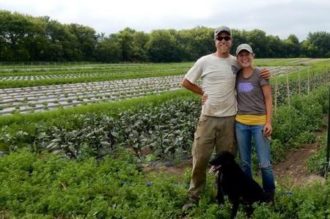Many vegetable farms use plastic mulch or film made from polyethylene to control weeds and conserve water. Third-generation farmers Dana and Karin Jokela are hopeful that integrating cover crops on their farm can reduce their dependence on this nonrenewable, non-biodegradable resource. They grow 12 acres of organic crops at Sogn Valley Farm in Cannon Falls, Minnesota, and one of their primary wholesale crops is peppers.
“Many growers, myself included, plant peppers on plastic mulch because of its soil warming, moisture retention, and weed suppression benefits,” said Dana Jokela. “While an effective tool for us, the waste generated through its disposal doesn’t align with our sustainability goals.”
With support from SARE, the Jokelas are attempting to reduce or eliminate plastic by interseeding cover crops at various dates into an established pepper crop.
Working with both plasticulture and bare ground systems, they hope the project will show how integrating cover crops can:
- reduce tillage and soil erosion
- add flowers for pollinators
- reduce weeding labor
- fixate nitrogen
- improve fruit quality due to reduced soil splash
- improve production
Dig Deeper
Learn more about experimenting with cover crops on your farm with Marianne Sarrantino’s article, “Testing Cover Crops on Your Farm.”
More information about this SARE project is available in this video.
